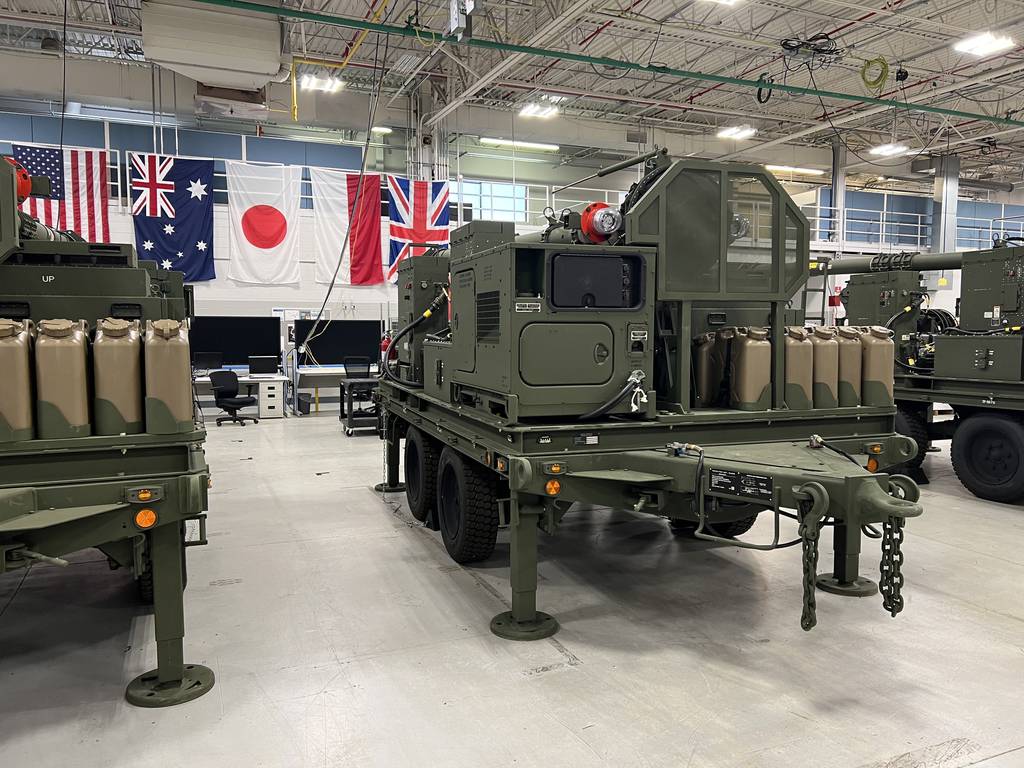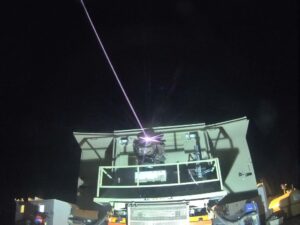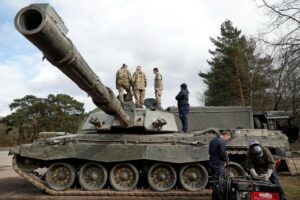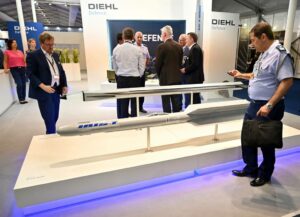
WARSAW, Poland, and COLOGNE, Germany — As European nations rush to buy interceptors, launchers and radars for missile defense, U.S. contractor Northrop Grumman sees an opening for its software designed to connect all the pieces.
The company organized an event with top executives in Warsaw on Nov. 16 in an apparent attempt to ensure that the Polish foothold in Europe for its Integrated Battle Command System, or IBCS, would survive the imminent change in government there.
Poland’s opposition last month won the country’s general election, replacing rule by the right-wing Law and Justice party that saw an unprecedented spending spree on defense equipment following Russia’s invasion of Ukraine. A coalition of center-right, liberal and left-wing parties took over control in the parliament this week, and a new cabinet is expected to be sworn in by the end of the year.
The political turnover comes as European allies are considering buying command-and-control systems for the national missile defense architectures that are beginning to emerge under the European Sky Shield Initiative, or ESSI, Northrop representatives said at the briefing.
Unveiled by German Chancellor Olaf Scholz in August 2022, the ESSI project initially comprised 15 NATO members. It has since expanded to 19 states.
Northrop is advertising its software as the U.S. glue in what aspires to become Europe’s contribution to a NATO missile shield, according to Bill Lamb, a senior program director with the company. “In terms of the challenges that NATO has, and our NATO allies have long had, it’s in the area of interoperability,” Lamb said.
This summer, company executives in the United States hinted that European interest was growing in IBCS, a system developed for the U.S. Army to the tune of billions of dollars.
In an interview with Defense News earlier this fall, German Air Force chief Lt. Gen. Ingo Gerhartz confirmed Berlin’s interest. “Right now, we are taking a close look at the IBCS system,” he said. “We need a C2 system to combine all the different capabilities,” he added, using military shorthand for command-and-control, the practice of orchestrating disparate forces to act as one.
Poland has been involved in the acquisition of the system for years. In 2018, the Warsaw government signed an agreement with the United States to purchase Patriot equipment powered by IBCS. Last September, the U.S. State Department signed off on a follow-on deal, potentially costing $4 billion.
Brig. Gen. Brig. Kazimierz Dyński, head of the Polish Armed Forces’ air and anti-missile defense force, said that Poland’s efforts in the field of air defense are largely driven by the experience of “640 days of a very brutal, kinetic war” in Ukraine.
“We have seen during this war what are the consequences of not having an integrated air defense system,” he said at the briefing. “I tell my subordinates: you are receiving a great system, a Patriot system connected with a C2 system, IBCS.”
Dyński said that Northrop’s solution will enable the Polish military to integrate its Wisla mid-range air defense system, which relies on Patriot batteries, with two other layers of air defense. These will comprise the nation’s short-range air defense systems, which are based on the Common Anti-air Modular Missiles, or CAMM, as well as iLaunchers from European consortium MBDA, and Pilica+ very-short-range air defense batteries developed by Poland’s defense industry.
Jaroslaw Adamowski is the Poland correspondent for Defense News.
Sebastian Sprenger is associate editor for Europe at Defense News, reporting on the state of the defense market in the region, and on U.S.-Europe cooperation and multi-national investments in defense and global security. Previously he served as managing editor for Defense News. He is based in Cologne, Germany.
- SEO Powered Content & PR Distribution. Get Amplified Today.
- PlatoData.Network Vertical Generative Ai. Empower Yourself. Access Here.
- PlatoAiStream. Web3 Intelligence. Knowledge Amplified. Access Here.
- PlatoESG. Carbon, CleanTech, Energy, Environment, Solar, Waste Management. Access Here.
- PlatoHealth. Biotech and Clinical Trials Intelligence. Access Here.
- Source: https://www.defensenews.com/battlefield-tech/2023/11/17/northrop-pushes-battle-command-tool-to-a-missile-defense-hungry-europe/
- :has
- :is
- :not
- 13
- 15%
- 16
- 19
- 2018
- 2022
- 70
- a
- According
- acquisition
- Act
- added
- Advertising
- Agreement
- AIR
- Air Force
- All
- an
- and
- apparent
- ARE
- AREA
- armed
- Army
- AS
- aspires
- Associate
- At
- attempt
- AUGUST
- based
- batteries
- Battle
- BE
- become
- been
- Beginning
- Bill
- Billion
- billions
- Briefing
- buy
- Buying
- by
- cabinet
- capabilities
- challenges
- chancellor Olaf Scholz
- change
- chief
- Close
- coalition
- Cologne
- combine
- comes
- Common
- company
- Comprised
- CONFIRMED
- Connect
- connected
- Consequences
- considering
- consortium
- Contractor
- contribution
- control
- cooperation
- country’s
- Days
- Defense
- Department
- designed
- developed
- different
- Director
- disparate
- dollars
- driven
- during
- Earlier
- editor
- efforts
- Election
- emerge
- enable
- end
- ensure
- equipment
- Europe
- European
- Europes
- Event
- executives
- expanded
- expected
- experience
- Fall
- field
- following
- For
- Force
- Forces
- from
- Gen
- General
- German
- Germany
- Global
- Government
- great
- had
- Have
- having
- he
- head
- hinted
- HTTPS
- Hungry
- images
- in
- industry
- initially
- Initiative
- integrate
- integrated
- interest
- Interoperability
- Interview
- invasion
- Investments
- involved
- IT
- ITS
- jpg
- Justice
- largely
- Last
- Law
- layers
- Long
- Look
- managing
- Market
- Members
- Military
- missiles
- modular
- Month
- multi-national
- my
- National
- Nations
- Need
- New
- news
- nov
- now
- of
- off
- on
- ONE
- opening
- opposition
- or
- Organized
- Other
- our
- over
- parliament
- parties
- party
- pieces
- plato
- Plato Data Intelligence
- PlatoData
- Poland
- Polish
- political
- potentially
- powered
- practice
- previously
- Program
- project
- purchase
- pushes
- receiving
- region
- Reporting
- Representatives
- Rule
- rush
- s
- Said
- saw
- security
- seen
- sees
- senior
- September
- served
- Shield
- shorthand
- signed
- since
- sky
- Software
- solution
- Spending
- spree
- State
- State Department
- States
- summer
- survive
- system
- Systems
- taking
- tell
- terms
- that
- The
- The Area
- The State
- There.
- These
- this
- this week
- to
- took
- tool
- top
- turnover
- two
- u.s.
- Ukraine
- under
- United
- United States
- unprecedented
- using
- very
- war
- Warsaw
- was
- we
- week
- WELL
- What
- which
- will
- with
- Won
- would
- year
- years
- you
- zephyrnet












